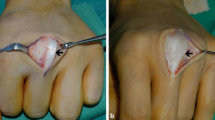Abstract
Introduction
The outcome of primary extensor repair in hand surgery has been widely explored, but little systematic effort has been made to investigate the influence of the anatomical zone of tendon injury. Therefore, the aim of our study was to assess the outcome of primary extensor tendon repair with a special focus on the pre-operative state and Verdan’s anatomical zones. Our hypothesis being tested was that the outcome after primary extensor repair depends on the complexity of trauma and the site of lesion.
Materials and methods
One hundred and seventy seven patients with 203 extensor tendon repairs were studied. After tendon repair and a 6-week protective immobilization, physiotherapy was carried out. A score proposed by Geldmacher and Schwarzbach was applied to estimate the outcome pre-operatively and to assess the results in a follow-up after a mean of 13 months. Correlations were tested between the anatomical zone of tendon injury, the pre-operative expectation and the results as considered both by the patient and the physician.
Results
In Verdan’s zones 1, 2, 4 and 5, excellent or good results were obtained in the vast majority of patients. Due to a higher frequency of complex injuries with concomitant soft tissue and bony injuries, the outcome was significantly worse after tendon repair in zones 3 and 6, as expected after the pre-operative estimation. In addition, a strong correlation was found for all anatomical zones between the pre-operative estimation and the outcome as judged both by the physician and the patient.
Conclusion
Recovery of finger function after primary extensor tendon repair depends on the complexity of trauma and the anatomical zone of tendon injury. Static splinting is an appropriate tool after primary extensor tendon repair in Verdan’s zone 1, 2, 4 and 5, whereas injuries in zones 3 and 6 may demand for a different treatment regimen.



Similar content being viewed by others
References
Chu MM (2002) Splinting programmes for tendon injuries. Hand Surg 7(2):243–249
Crosby CA, Wehbé MA (1999) Early protected motion after extensor tendon repair. J Hand Surg [Am] 24(5):1061–1070
Dargan EL (1969) Management of extensor tendon injuries of the hand. Surg Gynecol Obstet 128:1269–1273
Evans JD, Wignakumar V, Davis TRC, Dove A (1995) Results of extensor tendon repair performed by junior accident and emergency staff. Injury 26:107–109
Geldmacher J, Plank M, Treuheit KD (1986) Significance of the preoperative status in the evaluation of results of the reconstruction of extensor tendons. Handchir Mikrochir Plast Chir 18(1):23–29
Geldmacher J, Schwarzbach M (1990) Fresh extensor tendon injuries of the forearm and hand (management, results and problems). Langenbecks Arch Chir Suppl II Verh Dtsch Ges Chir 735–740
Hoch J, Losch GM, Schrader M (1988) Long-term results following reconstruction of the tendon of the extensor pollicis longus muscle by transposition of the tendon of the extensor indicis muscle. Handchir Mikrochir Plast Chir 20(2):93–96
Howell JW, Merritt WH, Robinson SJ (2005) Immediate controlled active motion following zone 4–7 extensor tendon repair. J Hand Ther 18(2):182–190
IP WY, Chow SP (1997) Results of dynamic splintage following extensor tendon repair. J Hand Surg [Br] 22:283–287
Khandwala AR, Webb J, Harris SB, Foster AJ, Elliot D (2000) A comparison of dynamic extension splinting and controlled active mobilization of complete divisions of extensor tendons in zones 5 and 6. J Hand Surg [Br] 25(2):140–146
Le Nen D, Escobar C, Stindel E, Marchand AC, Le Bigot P, Lefevre C, Courtois B (1993) Controlled mobilisation after suture of extensor tendons of the hand. Apropos of 30 consecutive cases. Rev Chir Orthop Reparatrice Appar Mot 79:194–199
Miller H (1942) Repair of severed tendons of the hand and wrist. Surg Gynecol Obstet 73:693
Newport ML, Tucker RL (2005) New perspectives on extensor tendon repair and implications for rehabilitation. J Hand Ther 18(2):175–181
Noorda RJ, Hage JJ (1994) Extensor indicis proprius transfer for loss of extensor pollicis longus function. Arch Orthop Trauma Surg 113(6):327–329
Purcell T, Eadie PA, Murugan S, O’Donnell M, Lawless M (2000) Static splinting of extensor tendon repairs. J Hand Surg [Br] 25:180–182
Rockwell WB, Butler PN, Byrne BA (2000) Extensor tendon: anatomy, injury and reconstruction. Plast Reconstr Surg 106:1592–1603
Russell RC, Jones M, Grobbelaar A (2003) Extensor tendon repair: mobilise or splint? Chir Main 22:19–23
Strickland JW, Glogovac SV (1980) Digital function following flexor tendon repair in zone II: a comparison of immobilization and controlled passive motion techniques. J Hand Surg 5:537–543
Sylaidis P, Youatt M, Logan A (1997) Early active mobilization for extensor tendon injuries. J Hand Surg [Br] 22:594–596
Woo SH, Tsai TM, Kleinert HE, Chew WY, Voor MJ (2005). A biomechanical comparison of four extensor tendon repair techniques in zone IV. Plast Reconstr Surg 115(6):1674–1683
Author information
Authors and Affiliations
Corresponding author
Rights and permissions
About this article
Cite this article
Carl, H.D., Forst, R. & Schaller, P. Results of primary extensor tendon repair in relation to the zone of injury and pre-operative outcome estimation. Arch Orthop Trauma Surg 127, 115–119 (2007). https://doi.org/10.1007/s00402-006-0233-3
Received:
Published:
Issue Date:
DOI: https://doi.org/10.1007/s00402-006-0233-3




